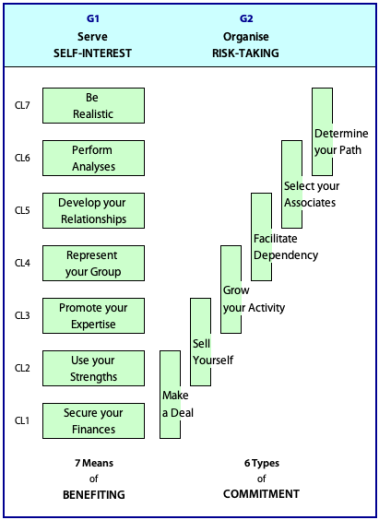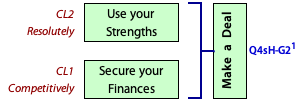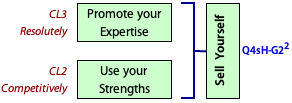Organise Risk-taking: G2

Risking via Commitment
Risking is dangerous, by definition. Some risks can be avoided but life without risk-taking is not advisable. Some risk-taking must be accepted and it can be focused and tamed for your benefit.
appears to be an intrinsic part of . Taming risk requires a pro-active approach in which the effort is analyzed for its potential dangers, and risky elements in the process are organised and managed.
By adding one adjacent monad, 6 dyadic groups are formed, each of which represents a risky challenge which demands a .
Self-assertion here is expressed as confidence that you can and will proceed to meet the challenge.
The qualifier for emerges from and is proposed as «resolutely». This means that in moving forward with the risky proposition you must be firm, bold, determined, relentless and unwavering. You cannot ensure your own interests if you are dithering, wavering, irresolute or over-cautious.
The effect of being resolute is that you are , and the dyads generate 3 groups in that regard:
-
Instrumental commitment i.e. using your self as a tool and pushing yourself forward without any expectation of special treatment in the lower two dyads: and .
-
Group commitment i.e. being ready to enter, join, form, manage and use groups in the middle two dyads: and .
-
Personal commitment i.e. caring for yourself and the quality of your relationships in the upper two dyads: and .
The 6 Dyadic Groups
G21: Make a Deal

Function: To use your resources well.
You need to secure your finances, but that should be based on using your relevant strengths.
«» is a generic label referring to or any commitment—enter a trade, buy a machine, take a job, employ a person—where sooner or later you expect to benefit financially. All commitments of this sort are risky because you do not know how they will turn out. The risk may be felt most intensely at the moment of commitment, but it persists as long as the deal is operative.
Your attempt to via the deal will be in competition with others as well as your counterparty. Applying your resolutely both in the decision and in the follow-through is essential.
The dyadic structure is shown at right.
Intrinsic Risks: The risk is that the deal goes awry sooner or later due to unexpected or unforeseeable events: the gain is not realized and losses may be threatened.![]() "Organising" means...
"Organising" means...
G22: Sell Yourself

Function: To get others to engage you without tangible proof.
You need to use your strengths, but that should be supported and directed by promoting your expertise.
When you apply for a new job or project or to join a team, you cannot know that you will succeed—nor does anyone on the other side. It is a risk for them and they will seek to consider a number of candidates. You need to to beat the competition. These strengths include your expertise, but often that is not the differentiating factor. Other strengths can be critical. They may be social like reputation or courtesy, psychological like willingness and enthusiasm, practical like convenience and speed, resource-based like access to a network or more finance.
Selling yourself needs a focus and that is naturally your , which must be resolutely.
The dyadic structure is shown at right.
Intrinsic Risk: The risk is that you end-up in a situation that is impossible for you to manage and succeed, which would mean failure and likely reputational damage.![]() "Organising" means...
"Organising" means...
G23: Grow your Activity

Function: To stabilize and strengthen your position.
You need to promote your expertise, and that should be supported and directed by representing your group.
Being complacent about your current state is passive and inherently risky because the world is in constant movement and competitors are always circling.
Growing any activity, project, outfit or enterprise which has you at the centre is likely to benefit you because, in a competitive world, bigger is stronger, safer, more admirable and more valuable. Growth typically improves stability, enhances reputation, enables diversification, and increases attractiveness to others. You may well end up with more control and more autonomy
In pursuing growth, there will be competition with others. So entering something completely new where you lack proven competence is unwise. Instead, you need to build on and . That promotion needs to be in the service of all involved in the activity. So you have to be resolute in .
The dyadic structure is shown at right.
Intrinsic Risk: The risk is that you dilute existing achievement and over-extend yourself or fail to retain the support of your group.
.![]() "Organising" means...
"Organising" means...
G24: Facilitate Dependency

Function: To provide certainty regarding your inputs and/or outputs.
You need to represent your group, but that should be supported and directed by developing loyal trusting relationships..
In , you will typically be in competition with other groups for your inputs of supplies and services or your outputs to clients and customers. To be assured that these will not be interrupted, you need to be resolute in . The stronger these relationships the more certain and confident you can be about getting what you need or about the demand for your service or product. The preferred result is for the external parties to depend on you because dependency makes it difficult for them to break off arrangements.
The dyadic structure is shown at right.
Intrinsic Risk: The risk is that dependency will operate in both ways. You will become dependent and therefore vulnerable. ![]() "Organising" means....
"Organising" means....
G25: Select your Associates

Function: To identify and relate to others who can be useful to you.
You need to develop strong relationships, but that time and effort should be directed by performing analyses.
There is possibly no choice more critical to your future than . This could be a business parter, your professional advisers, even your best friends or a life partner. It is necessary to resolutely in making such choices to avoid inadvertently engaging with someone quite inappropriate or lacking in desired qualities. While a transactional approach may get you impartial advice or cover social obligations, it will be is insufficient to guarantee trust and loyalty, or even the fullest attention. If you want to be able to depend on someone having your back, providing emotional support, doing whatever it takes, then you must develop a —and in this you will be competing with others in their network.
The dyadic structure is shown at right.
Intrinsic Risk: Any new person is an unknown in regard to their ability under pressure, reliability, overall personality and integrity. The risk is that your preferred associate lets you down when you least expect it, or their character drifts under stresses which you are unaware of, or he/she turns out to be a confidence trickster or fraud.![]() "Organising" means...
"Organising" means...
G26: Determine your Path

Function: To guide beneficial practical choices into the future.
You need to perform analyses, but that should be supported and directed by being realistic.
Your life is an endless progression through situations, most of which pass unnoticed. However, situations develop periodically that demand careful by you and by many others also affected. Their analyses will compete with yours. Whether or not you see the value in their analyses, you are well-advised to apply multiple perspectives to create competing analyses of your own. Where the choice is critical in , then you must be resolute in . That means not allowing wishful thinking, conformity to herd-thinking, or expedient passivity to shape your future.
The dyadic structure is shown at right.
Intrinsic Risk: The risk is that you are not seeing matters realistically because of blind spots, sheer ignorance, or pressures from others.![]() "Organising" means...
"Organising" means...
Transition
At this stage your personal vulnerability () has been protected by immediate self-assertion, and through focused risk-taking () you can establish a more lasting foothold in society.
However, you require broader social presence, one recognized by others; and this requires you to expose yourself so that others and see where you stand.
This is made possible by adding an additional adjacent level to form triads.
- Continue with exposure-G3 Triads.
- Go to the review to see the full picture.
Originally posted: 10-July-2025